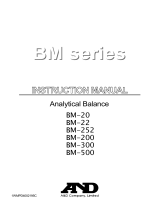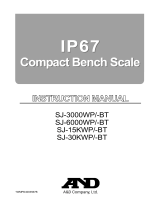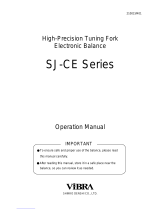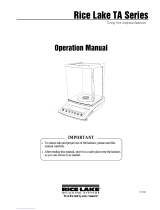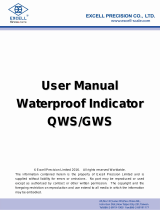Page is loading ...

GP SERIES
GP-12K/GP-20K /GP-30K/GP-32K
G
P-40K/GP-60K/GP-61K
G
P-100K/GP-102K
GP-30KS/GP-32KS
GP-60KS/ GP-61KS/GP-100KS
Precision Balance
INSTRUCTION MANUAL
1WMPD4000273E

© 2014 A&D Company Ltd. All rights reserved.
No part of this publication may be reproduced, transmitted, transcribed, or translated
into any language in any form by any means without the written permission of A&D
Company Ltd.
The contents of this manual and the specifications of the instrument covered by this
manual are subject to change for improvement without notice.

1
CONTENTS
Basic operation
1. INTRODUCTION ............................................................................................................................ 3
1-1 About This Manual ..............................................................................................................................3
1-2 Features ..............................................................................................................................................3
1-3 Compliance .........................................................................................................................................5
2. UNPACKING THE BALANCE........................................................................................................7
2-1 Unpacking ...........................................................................................................................................7
2-2 Installing the Balance..........................................................................................................................8
3. PRECAUTIONS.............................................................................................................................. 9
3-1 Before Use ..........................................................................................................................................9
3-2 During Use ..........................................................................................................................................9
3-3 After Use............................................................................................................................................10
3-4 Power Supply ....................................................................................................................................10
3-5 Display Symbols and Key Operation ................................................................................................ 11
3-6 Smart Range Function ......................................................................................................................12
4. WEIGHING UNITS........................................................................................................................ 13
4-1 Units ..................................................................................................................................................13
4-2 Changing the Units............................................................................................................................16
5. WEIGHING ................................................................................................................................... 17
5-1 Basic Operation (Kilogram Mode).....................................................................................................17
5-2 Counting Mode (PCS).......................................................................................................................18
5-3 Percent Mode (%) .............................................................................................................................20
5-4 Animal Weighing Mode (Hold Function)............................................................................................20
5-5 Accumulation Function......................................................................................................................21
Adapting to the environment
6. RESPONSE ADJUSTMENT / SELF CHECK FUNCTION ........................................................... 23
6-1 Automatic Response Adjustment / Self Check Function...................................................................23
6-2 Manual Response Adjustment ..........................................................................................................24
7. CALIBRATION.............................................................................................................................. 25
7-1 Calibration Group ..............................................................................................................................25
7-2 Automatic Self Calibration (Calibration due to changes in temperature)..................................................26
7-3 Calibration Using the Internal mass (One-Touch Calibration)...........................................................27
7-4 Calibration Using an External Weight ...............................................................................................28
7-5 Calibration Test Using an External Weight........................................................................................30
7-6 Correcting the Internal Mass Value...................................................................................................32
8. FUNCTION SWITCH AND INITIALIZATION ................................................................................ 34
8-1 Permit or Inhibit .................................................................................................................................34
8-2 Initializing the Balance ......................................................................................................................35
9. FUNCTION TABLE....................................................................................................................... 36
9-1 Structure and Sequence of the Function Table.................................................................................36
9-2 Display and Keys ..............................................................................................................................36
9-3 Details of the Function Table.............................................................................................................37
9-4 Description of the Class “Environment, Display” ..............................................................................40
9-5 Description of the Item “Data output mode” ......................................................................................42
9-6 Description of the Item “Data format”................................................................................................43
9-7 Description of the Data Format Added to the Weighing Data..................................................................45

2
9-8 Data Format Examples .....................................................................................................................46
9-9 Clock and Calendar Function............................................................................................................48
9-10 Comparator Function ......................................................................................................................50
9-11 Adding the Comparison Results......................................................................................................52
9-12 Main Display Comparison Function ................................................................................................52
10. ID NUMBER AND GLP REPORT............................................................................................... 54
10-1 Setting the ID Number.....................................................................................................................54
10-2 GLP Report .....................................................................................................................................55
11. DATA MEMORY.......................................................................................................................... 58
11-1 Notes on Using Data Memory .........................................................................................................58
11-2 Memory for Weighing Data..............................................................................................................59
11-3 Memory for Calibration and Calibration Test Data ..........................................................................62
11-4 Memory for Unit Mass in the Counting Mode..................................................................................63
11-5 Memory for Comparator Settings ....................................................................................................65
11-6 Memory for Tare Value ....................................................................................................................67
11-7 Data Memory: Quick Selection Mode..............................................................................................71
11-8 Data Memory: Confirmation and Storage Mode..............................................................................72
12. PROGRAMMABLE-UNIT ........................................................................................................... 73
13. DENSITY MEASUREMENT ....................................................................................................... 74
RS-232C serial interface
14. I/O UNIT SPECIFICATIONS (Standard) .................................................................................... 77
14-1 RS-232C//External Contact Input ..........................................................................................................77
15. CONNECTION TO PERIPHERAL EQUIPMENT........................................................................ 79
15-1 Connection to the AD-8121B Printer...............................................................................................79
15-2 Connection to a Computer ..............................................................................................................79
15-3 Using Windows Communication Tools (WinCT) .............................................................................80
15-4 Using the WinCT software, the balance can do the following:........................................................80
16. COMMANDS .............................................................................................................................. 81
16-1 Command List .................................................................................................................................81
16-2 Acknowledge Code and Error Codes..............................................................................................82
16-3 Control Using CTS and RTS...........................................................................................................82
16-4 Settings Related to RS-232C..........................................................................................................82
Maintenance
17. MAINTENANCE ......................................................................................................................... 83
18. TROUBLESHOOTING................................................................................................................ 83
18-1 Checking the Balance Performance and Environment ...................................................................83
18-2 Error Codes.....................................................................................................................................84
18-3 Asking For Repair............................................................................................................................86
19. SPECIFICATIONS ...................................................................................................................... 87
20. EXTERNAL DIMENSIONS ......................................................................................................... 89
21. OPTIONS.................................................................................................................................... 91
22. TERMS/INDEX ........................................................................................................................... 93

3
1. INTRODUCTION
This manual describes how the GP series balance works and how to get the most out of it in terms
of performance.
Read this manual thoroughly before using the balance and keep it at hand for future reference.
1-1 About This Manual
This manual consists of the following five parts:
Basic operation .............................. Describes precautions on handling the balance, balance
construction and basic balance operation.
Adapting to the environment .......... Describes response adjustment, calibration and calibration
test.
Functions ....................................... Describes various functions of the balance.
RS-232C serial interface................... Describes RS-232C serial interface output and external contact
input. The RS-232C serial interface outputs weighing data and
controls the balance. The external contact input commands the
balance re-zeroing and data output.
Maintenance................................... Describes maintenance, error codes, troubleshooting,
specifications and options.
1-2 Features
Large Vacuum Fluorescent Display, easy to read.
Dust-tight and Protected Against Water Jets (Complying with IP65), allows washing with water.
Built-in Calibration Weight (hereinafter referred to as internal mass), allows easy calibration,
adjustment and maintenance of the balance.
Automatic Self Calibration, using the internal mass, adapting to changes in temperature.
Self Check Function, provided to self-check the balance using the internal mass.
Automatic Response Adjustment, adapting to vibration and drafts in the environment.
High Response Speed, the time to read a displayed value after a sample is placed on the pan
has been shortened by using the Super Hybrid Sensor (SHS). (Approx. 1.5 seconds when
FAST is selected for the response rate.)
Data Memory Function, storing weighing data, calibration data or unit mass in the counting
mode. It can also store tare values or upper and lower limit values for the comparator function.
Interval Memory Mode is provided to store the weighing data periodically.
Good Laboratory Practice (GLP) data output using the standard RS-232C serial interface.
Clock and Calendar Function, adding the time and date to the output data.
Comparator Indicators, displaying the comparison results, H I, OK or LO.
Capacity Indicator, displaying the weight value in percentage relative to the weighing capacity.

4
Hold Function, provided for weighing a moving object such as an animal.
Multiple Weighing Units, with most of the common units used around the world.
Density Mode, for calculating the density of a solid.
Accumulation Function, adding the weight values and outputting the sum.
Adjustable Display Position, the standard type balance has a swing-arm to adjust the display
position for optimum viewing.
Separate display type balances (GP-30KS/32KS/60KS/61KS/100KS) are also available.
Windows Communication Tools (WinCT), allows easy communication with Windows.
Windows is a registered trademark of Microsoft Corporation.
Reference Card, provided for a quick reference to the balance operation.
Underhook, available as an option, for measuring density and weighing magnetic materials.
Comparator Output (OP-04) and Analog Voltage Output (OP-06) are available as options.

5
1-3 Compliance
Compliance with FCC Rules
Please note that this equipment generates, uses and can radiate radio frequency energy. This
equipment has been tested and has been found to comply with the limits of a Class A
computing device pursuant to Subpart J of Part 15 of FCC rules. These rules are designed to
provide reasonable protection against interference when equipment is operated in a
commercial environment. If this unit is operated in a residential area, it may cause some
interference and under these circumstances the user would be required to take, at his own
expense, whatever measures are necessary to eliminate the interference.
(FCC = Federal Communications Commission in the U.S.A.)
Compliance With Directives of CE mark
This device features radio interference suppression, safety regulation and restriction of
Hazardous Substances in compliance with the following Council Directives
Council directive 2004/108/EC EN61326 EMC directive
Council directive 2006/95/EC EN60950 Safety of Information Technology Equipment
Council directive 2011/65/EU EN50581 Restriction of the use of certain Hazardous Substances
The CE mark is an official mandatory European marking.
Please note that any electronic product must comply with local laws and regulations when sold
or used anywhere outside Europe.

6

7
2. UNPACKING THE BALANCE
2-1 Unpacking
The balance is a precision instrument. Unpack the balance carefully. Keep the packing
material to be used for transporting the balance in the future.
The packing contents depend on the balance model. See the illustrations to confirm that
everything is contained.
Standard type: GP-12K/20K/30K/32K/40K/60K/61K/100K/102K
Note
Please confirm that the AC adapter type is correct
for your local voltage and receptacle type.

8
Separate display type: GP-30KS/32KS/60KS/61KS/100KS
Note
Please confirm that the AC adapter type is correct
for your local voltage and receptacle type.
2-2 Installing the Balance
Install the balance as follows:
1. Refer to “3. PRECAUTIONS” for installing the balance.
2. Adjust the leveling feet to level the balance. Confirm it using the bubble spirit level.
3. Confirm that the adapter type is correct for the local voltage and power receptacle type.
4. Connect the AC adapter to the balance. Warm up the balance for at least 30 minutes with
nothing on the weighing pan.

9
3. PRECAUTIONS
To get the optimum performance from the balance and acquire accurate weighing data, note the
following:
3-1 Before Use
Install the balance in an environment where the
temperature and humidity are not excessive. The best
operating temperature is about 20°C / 68°F at about
50% relative humidity.
Install the balance where it is not exposed to direct sunlight
and it is not affected by heaters or air conditioners.
Install the balance where it is free of dust.
Install the balance away from equipment which
produces magnetic fields.
Install the balance in a stable place avoiding vibration
and shock. Corners of rooms on the first floor are best,
as they are less prone to vibration.
The weighing table should be solid and free from
vibration, drafts and as level as possible.
Level the balance by adjusting the leveling feet and
confirm it using the bubble spirit level.
Ensure a stable power source when using the AC adapter.
Plug in the AC adapter and warm up the balance for at
least 30 minutes.
Calibrate the balance periodically for accurate weighing.
When the balance is installed for the first time or has been
moved, warm up the balance for at least 12 hours to allow
the balance to reach equilibrium with the ambient
temperature, and then perform calibration before use.
Caution
Please confirm that the AC adapter type is correct for your local voltage and receptacle type.
Do not install the balance where flammable or corrosive gas is present.
3-2 During Use
Discharge static electricity from the material to be
weighed (hereinafter referred to as sample). When a
sample could have a static charge, the weighing data
is influenced. Try to keep the ambient humidity above
45%RH or use the metal shield case.

10
This balance uses a strong magnet as part of the
balance assembly, so please use caution when
weighing magnetic materials such as iron. If there is a
problem, use the underhook on the bottom of the
balance to suspend the material away from the
influence of the magnet.
Cancel the temperature difference between a sample
and the environment. When a sample is warmer
(cooler) than the ambient temperature, the sample will
be lighter (heavier) than the true weight. This error is
due to a rising (falling) draft around the sample.
Make each weighing gently and quickly to avoid errors
due to changes in the environmental conditions.
Do not drop things upon the weighing pan, or place a
sample on the pan that is beyond the balance weighing
capacity. Place a sample in the center of the weighing pan.
Do not use a sharp instrument such as a pencil to
press the keys. Use your finger only.
Press the RE-ZERO key before each weighing to
prevent possible errors.
Calibrate the balance periodically so as to cancel
possible errors.
Take into consideration the affect of air buoyancy on a
sample when more accuracy is required.
Keep the balance interior free of dust and foreign
materials.
3-3 After Use
Avoid mechanical shock to the balance.
Do not disassemble the balance. Contact the local A&D dealer if the balance needs service or repair.
Do not use organic solvents to clean the balance. Clean the balance with a lint free cloth that
is moistened with warm water and a mild detergent.
Do not allow the balance to be immersed in water. Even though the balance complies with
IP65 (Dust-tight and Protected Against Water Jets), the balance will not withstand being
completely immersed in water.
3-4 Power Supply
Do not remove the AC adapter while the internal mass is in motion, for example, right after the
AC adapter is connected, or during calibration using the internal mass.
If the AC adapter is removed under the conditions described above, the internal mass will be
left unsecured, that may cause mechanical damage when the balance is moved.
Before removing the AC adapter, press the ON:OFF key and confirm that zero is displayed.
When the AC adapter is connected, the balance is in the standby mode if the standby indicator
is on (refer to “3-5 Display Symbols and Key Operation”). This is a normal state and does not
harm the balance. For accurate weighing, keep the AC adapter connected to the balance and AC
power unless the balance is not to be used for a long period of time.

11
3-5 Display Symbols and Key Operation
Key operation
Key operation affects how the balance functions. The basic key operations are:
“Press and release the key immediately” or “Press the key”
= normal key operation during measurement
“Press and hold the key”
Display symbols
Each key, when pressed or when pressed and held, functions as follows:
Key When pressed When pressed and held
Turns the display ON and OFF. The standby indicator is displayed when the display is
turned off. The weighing mode is enabled when the display is turned on.
This key is available anytime. Pressing the key during operation will interrupt the
operation and turn the display OFF.
In the weighing mode, turns the minimum
weighing value ON and OFF.
In the counting or percent mode, enters
the sample storing mode.
Enters the function table mode. Refer to
“9. FUNCTION TABLE”.
Switches the weighing units stored in the
function table. Refer to “4. WEIGHING
UNITS”.
Performs response adjustment and self
check.
Performs calibration of the balance using
the internal mass.
Displays other items of the calibration
menu.
Stores the weighing data in memory or
outputs to a printer or personal computer
depending on the function table settings.
(Factory setting = output)
No function at the factory setting
By changing the function table:
Outputs “Title block” and “End block” for
GLP report.
Displays the data memory menu.
Sets the display to zero.

12
3-6 Smart Range Function
The GP-32K, GP-32KS and GP-102K are equipped with two ranges. The precision range has a
higher resolution. The standard range has normal resolution.
The range is switched automatically, depending on the value displayed. Pressing the RE-ZERO key
allows weighing in the precision range, regardless of the tare value. (Smart range function)
The range can be fixed to the standard range, by pressing the SAMPLE key.
Note
Once the range is switched to the standard range, it will not switch to the precision range
automatically even when the displayed value becomes within the precision range value. Use
the RE-ZERO or SAMPLE key to activate the precision range again.
Below is a description of how the Smart Range actually functions, using the GP-102K
(Precision range=61 kg1 g, Standard range=101 kg10 g)
1 Press the RE-ZERO key.
The balance will start weighing, using the
precision range.
2 Place a container, on the weighing pan, to be
used as a tare.
The value displayed exceeds the precision
range value. So, the range will be switched to
the standard range.
3 Press the RE-ZERO key.
The balance will be switched to the precision
range.
4 Place a sample on the pan.
The value displayed is within the precision
range value. So, the balance will perform a
weighing, using the precision range.
Precision range/standard range value
GP-32K/GP-32KS GP-102K
Precision range
(after RE-ZERO is pressed)
Up to 6.1009 kg Up to 61.009 kg
Standard range 6.101 to 31.008 kg 61.01 to 101.08 kg

13
4. WEIGHING UNITS
4-1 Units
With the GP series balance, the following weighing units and weighing modes are available :
A unit or mode can be selected and stored in the function table as described in “4-2 Changing the Units”.
If a weighing mode (or unit of weight) has been turned off, that mode or unit will be missing in the
sequence. Tael has four varieties, one of which can be selected and installed at the factory.
For details about the units and modes, see the table below:
Name (unit, mode) Abbrev. Display Function table
(Storing mode)
Conversion factor
1 g =
Gram g G 1 g
kilogram kg 1000 g
Counting mode PCS
Percent mode
Ounce (Avoir) OZ 28.349523125 g
Pound Lb 453.59237 g
Pound/Ounce L OZ l0 1Lb=16 oz,
1 oz=28.349523125 g
Troy Ounce OZt 31.1034768 g
Metric Carat ct 0.2 g
Momme mom 3.75 g
Pennyweight dwt 1.55517384 g
Tael (HK general, Singapore) 37.7994 g
Tael (HK jewelry) 37.429 g
Tael (Taiwan) 37.5 g
Tael (China)
TL
31.25 g
Tola (India) t 11.6638038 g
Messghal MS 4.6875 g
Density mode
DS
is used to
show the density.
Programmable-unit (Multi-unit) Mlt
Note: The units, g, ct and dwt are not available for the GP-102K.

14
The tables below indicate the weighing capacity and the minimum display for each unit, depending
on the balance model.
GP-12K GP-20K GP-30K
GP-30KS
GP-61K
GP-61KS
GP-40K Unit
Capacity
Minimum
display
Capacity
Minimum
display
Gram 12000.0 21000.0 31000.0 61000.0 0.1 41000.0 0.5
Kilogram 12.0000 21.0000 31.0000 61.0000 0.0001 41.0000 0.0005
Ounce (Avoir) 423.290 740.755 1093.495 2151.710 0.005 1446.24 0.02
Pound 26.4555 46.2970 68.3435 134.4820 0.0005 90.390 0.002
Pound/Ounce 26L 7.29 46L 4.75 68L 5.49 134L 7.7 0.01 90L 6.24 0.02
Troy Ounce 385.810 675.165 996.675 1961.195 0.005 1318.18 0.02
Metric Carat 60000.0 105000.0 155000.0 305000.0 0.5 205000 5
Momme 3200.00 5600.00 8266.65 16266.65 0.05 10933.4 0.2
Pennyweight 7716.2 13503.3 19933.5 39223.9 0.1 26363.5 0.5
Tael (HK general,
Singapore)
317.465 555.565 820.120 1613.780 0.005 1084.68
0.02
Tael (HK jewelry) 320.605 561.060 828.235 1629.750 0.005 1095.40 0.02
Tael (Taiwan) 320.000 560.000 826.665 1626.665 0.005 1093.34 0.02
Tael (China) 384.000 672.000 992.000 1952.000 0.005 1312.00 0.02
Tola (India) 1028.82 1800.44 2657.80 5229.85 0.01 3515.15 0.05
Messghal 2560.00 4480.00 6613.35 13013.35 0.05 8746.6 0.2
GP-60K
GP-60KS
GP-100K
GP-100KS
Unit
Capacity
Minimum
display
Gram 61000 101000 1
Kilogram 61.000 101.000 0.001
Ounce (Avoir) 2151.70 3562.65 0.05
Pound 134.480 222.665 0.005
Pound/Ounce 134L 7.7 222L 10.7 0.1
Troy Ounce 1961.20 3247.25 0.05
Metric Carat 305000 505000 5
Momme 16266.5 26933.5 0.5
Pennyweight 39224 64945 1
Tael (HK general,
Singapore)
1613.80 2672.00 0.05
Tael (HK jewelry) 1629.75 2698.45 0.05
Tael (Taiwan) 1626.65 2693.35 0.05
Tael (China) 1952.00 3232.00 0.05
Tola (India) 5229.9 8659.3 0.1
Messghal 13013.5 21546.5 0.5

15
GP-32K/ GP-32KS
Standard range Precision range
Unit
Capacity Minimum display Capacity Minimum display
Gram 31000 1 6100.0 0.1
Kilogram 31.000 0.001 6.1000 0.0001
Ounce (Avoir) 1093.50 0.05 215.170 0.005
Pound 68.345 0.005 13.4480 0.0005
Pound/Ounce 68L 5.5 0.1 13L 7.17 0.01
Troy Ounce 996.65 0.05 196.120 0.005
Metric Carat 155000 5 30500.0 0.5
Mom me 8266.5 0.5 1626.65 0.05
Pennyweight 19933 1 3922.4 0.1
Tael (HK general,
Singapore)
820.10 0.05 161.380 0.005
Tael (HK jewelry) 828.25 0.05 162.975 0.005
Tael (Taiwan) 826.65 0.05 162.665 0.005
Tael (China) 992.00 0.05 195.200 0.005
Tola (India) 2657.8 0.1 522.99 0.01
Messghal 6613.5 0.5 1301.35 0.05
GP-102K
Standard range Precision range
Unit
Capacity Minimum display Capacity Minimum display
Gram
- - - -
Kilogram 101.00 0.01 61.000 0.001
Ounce (Avoir) 3562.5 0.5 2151.70 0.05
Pound 222.65 0.05 134.480 0.005
Pound/Ounce 222L 11 1 134L 7.7 0.1
Troy Ounce 3247.0 0.5 1961.20 0.05
Metric Carat
- - - -
Momme 26935 5 16266.5 0.5
Pennyweight
- - - -
Tael (HK general,
Singapore)
2672.0 0.5 1613.80 0.05
Tael (HK jewelry) 2698.5 0.5 1629.75 0.05
Tael (Taiwan) 2693.5 0.5 1626.65 0.05
Tael (China) 3232.0 0.5 1952.00 0.05
Tola (India) 8659 1 5229.9 0.1
Messghal 21545 5 13013.5 0.5

16
4-2 Changing the Units
The units or modes can be selected and stored in the function table. The sequence of displaying the
units or modes can be arranged so as to fit the frequency of use in the function table.
Select a unit or mode and arrange the sequence of display as follows:
1 Press and hold the SAMPLE key until ba5fnc of the
function table is displayed, then release the key.
2 Press the SAMPLE key several times to display
Unit .
3 Press the PRINT key to enter the unit selection mode.
4 Specify a unit or mode in the order to be displayed
using the following keys.
SAMPLE key To sequentially display the units.
RE-ZERO key To specify a unit or mode. The
stabilization indicator appears when
the displayed unit or mode is
specified.
5 Press the PRINT key to store the units or modes.
The balance displays end and then displays the
next menu item of the function table.
6 Press the CAL key to exit the function table. Then the
balance returns to the weighing mode with the
selected unit.

17
5. WEIGHING
5-1 Basic Operation (Kilogram Mode)
1 Place a container on the weighing pan, if necessary.
Press the RE-ZERO key to cancel the weight (tare). The
balance displays 0.0000 kg. (The decimal point position
depends on the balance model.)
2 Place a sample on the pan or in the container.
3 Wait for the stabilization indicator to be displayed. Read
the value.
4 Remove the sample and container from the pan.
Notes
To use another unit, press the MODE key and select an
appropriate unit.
Press the SAMPLE key to turn on or off the minimum
weighing value.
The weighing data can be stored in memory. For details,
refer to “11. DATA MEMORY”.

18
5-2 Counting Mode (PCS)
This is the mode to determine the number of objects in a sample based on the standard sample unit
mass. Unit mass means the mass of one sample. The smaller the variables in each sample unit
mass is, the more accurate the counting will be. The GP series balance is equipped with the
Automatic Counting Accuracy Improvement (ACAI) function to improve the counting accuracy.
Note
If the sample unit mass variable, the difference from sample to sample, is too large, it may
cause a counting error.
Selecting the counting mode
1 Press the MODE key to select pcs (counting mode).
Storing a sample unit mass (Weighing input mode)
2 Press the SAMPLE key to enter the sample unit mass
storing mode.
3 To select the number of samples, press the SAMPLE key
several times. It may be set to 10, 25, 50 or 100.
Note
A greater number of samples will yield more accurate
counting result.
4 Place a container on the weighing pan, if necessary.
Press the RE-ZERO key to cancel the weight (tare). The
number specified in step 3 appears.
e.g.: 25 0
pcs is displayed if 25 is selected in step 3.
5 Place the number of samples specified on the pan. In this
example, 25 pieces.
6 Wait for the stabilization indicator to come on. Press the
PRINT key to calculate and store the unit mass. The
balance displays 25 pcs (counting mode) and is set to
count samples with this unit mass. (The sample unit mass
stored, even if the AC adapter is removed, is maintained
in non-volatile memory.)
To improve the accuracy of the unit mass, proceed to step 8.
Notes
If the balance judges that the mass of the samples is too
light and can not be stored as the unit mass, it displays
lo .
If the balance judges that the mass of the samples is too light to aquire accurate weighing, it
displays an error requiring the addition of more samples to the specified number. In the
example above, 150- pcs appears, requiring 25 more samples. Add 25 samples and press
the PRINT key. When the unit mass is stored correctly, the balance proceeds to the counting mode.
Key entry of the unit mass value (digital input mode) is possible. For details, refer to “11-4
Memory for Unit Mass in the Counting Mode”
/


